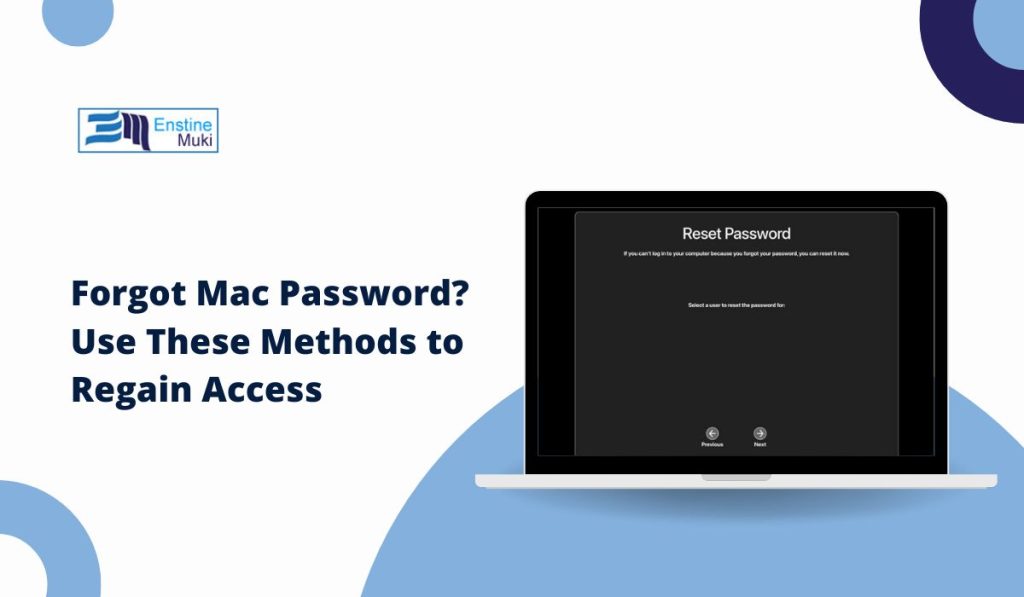Forgetting your Mac password can be frustrating—especially when you’re locked out and unable to access important files. Luckily, Apple has multiple built-in methods to help you reset your password without losing any data. This guide breaks down the steps you can take to regain access to your Mac, troubleshoot common issues, and avoid future lockouts.
Why Is Your Mac Password Important?
Your Mac password isn’t just a login credential; it’s the key to your system. It keeps your data secure, prevents unauthorized access, and is needed to make administrative changes. Forgetting it can leave you locked out, but rest assured—there are solutions to get you back in.
Common Methods to Unlock Your Mac
Here’s how you can regain access to your Mac based on the most effective solutions Apple offers.
1. Use Your Apple ID to Reset the Password
If you’ve linked your Apple ID to your Mac, resetting your password is straightforward:
- On the login screen, click “Reset it using your Apple ID”.
- Enter your Apple ID email and password.
- Follow the prompts to create a new Mac password.
- Use the new password to log in.
Quick Note: Ensure your Mac is connected to Wi-Fi for this method to work.
2. Reset the Password in Recovery Mode
If your Apple ID isn’t linked, Recovery Mode can help:
- Restart your Mac and hold Command (⌘) + R during startup.
- From the top menu, go to Utilities > Terminal.
- Type
resetpasswordand hit Enter. - Follow the on-screen instructions to reset your password.
- Restart your Mac and log in using the new password.
3. Unlock with Another Administrator Account
If your Mac has another administrator account, you can reset the password through it:
- Log into the other administrator account.
- Go to System Preferences > Users & Groups.
- Select the locked account and click Reset Password.
- Enter a new password and save it.
Pro Tip: Always set up an additional administrator account for emergencies.
Advanced Troubleshooting Methods
If the above methods don’t work, try these advanced options.
Use the FileVault Recovery Key
If your Mac has FileVault enabled, your disk is encrypted to protect your data. This feature enhances security but requires a recovery key to unlock the device if you forget your password. Here’s how to use it:
- Locate Your Recovery Key: The recovery key is a unique code provided when FileVault encryption was initially enabled. You may have saved it to iCloud, written it down, or stored it securely elsewhere.
- Enter the Key at Login: On the login screen, when prompted, input your recovery key instead of your password. This will unlock the encrypted disk.
- Access System Preferences: Once logged in, go to System Preferences > Users & Groups.
- Reset Your Password: Select your account and click Reset Password to create a new password. Ensure you save the changes for future use.
Pro Tip: Always store your recovery key in a secure location. Without it, accessing your Mac becomes significantly more difficult if you lose your password.
Boot into Safe Mode
Safe Mode is a diagnostic tool that can help resolve login issues caused by software conflicts, corrupt files, or startup glitches. It disables unnecessary processes and performs basic system checks. Follow these steps to use Safe Mode effectively:
- Begin by shutting down your Mac completely.
- Turn your Mac back on and immediately press and hold the Shift key. Release the key when you see the Apple logo or the login screen.
- Use your current password or recovery key to log in. Safe Mode will load with minimal system processes running.
- Navigate to System Preferences > Users & Groups. Select your account, then choose Reset Password to create a new one.
Quick Tip: While in Safe Mode, you might notice slower performance—this is normal since the Mac runs limited features during this mode.
Reset Password Using Terminal Commands
For advanced users, Terminal is a powerful tool to reset your Mac password, but it should be used with caution. Terminal commands directly interact with the system, and incorrect inputs could lead to issues. Here’s the step-by-step process:
- Restart your Mac and press and hold Command (⌘) + R during startup. Keep holding until you see the macOS Utilities screen.
- From the Utilities menu, select Terminal. This opens a command-line interface where you’ll input specific commands.
- Type
resetpassword(as one word) and press Enter. This will open the Password Reset Utility. - In the utility, select your user account, enter a new password, and confirm it.
- Once the password reset is complete, restart your Mac and log in with the new password.
Caution: Terminal is a powerful tool, but it’s not beginner-friendly. Avoid experimenting with commands outside of this guide to prevent unintended system changes.
Preventing Future Password Issues
Avoid getting locked out again by following these tips:
FAQs About Resetting Mac Passwords
1. What if I forgot both my Mac password and Apple ID?
You’ll need to contact Apple Support and provide proof of ownership to regain access.
2. Can I reset my Mac password without losing data?
Yes, methods like using your Apple ID or Recovery Mode will preserve your data.
3. What if FileVault is enabled?
You’ll need the FileVault recovery key or Apple ID to unlock the encrypted disk.
Conclusion
Forgetting your Mac password is inconvenient but far from irreversible. With tools like Apple ID, Recovery Mode, and secondary administrator accounts, you can regain access quickly and safely. To avoid future issues, set up password hints, use iCloud Keychain, and create a backup administrator account.
Have more questions or tips about unlocking a Mac? Drop your thoughts in the comments below—we’d love to hear from you!

